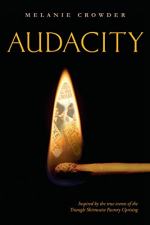|
This section contains 854 words (approx. 3 pages at 400 words per page) |

|
Audacity Summary & Study Guide Description
Audacity Summary & Study Guide includes comprehensive information and analysis to help you understand the book. This study guide contains the following sections:
This detailed literature summary also contains Quotes and a Free Quiz on Audacity by Melanie Crowder.
The following version of this book was used to create the guide: Crowder, Melanie. Audacity. Philomel Books, 2015.
Audacity takes place in the early 20th century and is told through the eyes and narrative voice of Clara Lemlich, an adolescent Jewish girl who is raised in a small shtetl in Eastern Europe with her father, mother, and three brothers, Nathan, Marcus, and Benjamin. Clara’s dreams to become an educated doctor are continuously undermined by her culture and family’s religious beliefs that men are designed to maintain the intellectuality of their faith, while women are meant to maintain domestic tasks and be properly primed for marriage. Despite these limitations, Clara feels a deep inclination towards learning and achieving independence, and she resents the gendered classification of tasks and intellect. Though forbidden to do so, she seeks out opportunities to educate herself privately and cherishes her contraband books, poetry, and songs that she reads with her friends Hanna and Miriam.
During the first section of the novel, entitled “tinder,” Clara introduces the reader to her home shtetl and the Jewish customs that dictate daily life. However, amidst a political climate filled with xenophobic rhetoric fueled by anti-Semitic propaganda, the safety of their shtetl becomes compromised when Jews are blamed for the death of a Christian boy in Kiev, igniting a hateful and deathly pogrom in Clara’s home village. Clara and her family are forced to spend the night hiding in the forest while Christian peasants destroy the community on a murderous rampage. There is extreme damage made to the village property and hundreds of innocent Jews are killed in the attack, and the Lemlich’s make the difficult decision to begin the long journey to immigrate to America.
Throughout section two of the novel, “spark,” the Lemlich family travel by carriage and train through Germany and then by boat to England, encountering brutality and aggression by German border guards along the way. In England, the family is forced to stay in a poorhouse alongside hundreds other refugee families for months before travelling to America by ship in December 1904. Though the journey marks their freedom from anti-Semitic danger, Clara’s family and fellow third-class passengers are forced to sacrifice their comfort, religious practices, and even some lives during the tumultuous journey overseas. Upon arrival in New York, Clara’s brother Nathan is denied entry because of a lung infection and is kept in quarantine on Ellis Island. The Lemlich’s attempt begin their new lives in the concrete jungle of New York, marked by poverty, grief, and pure exhaustion.
During the third section of the novel, “flame,” Clara and her mother are forced to seek work while her father and brothers commit to their daily prayers, and Clara is forced to accept the only job available at a sweatshop. Clara witnesses the extreme exploitation and abuse that riddles the garment industry which targets impoverished immigrants and she becomes inspired to create change to combat that inequality. Discovering the New York Public Library and Jacob Gordon Free School, Clara establishes safe places for her independent growth and education, exhibiting agency outside of her family’s socio-religious customs for the first time in her life. One day, Clara speaks out against sexual harassment in the workplace at the hands of the bosses and is fired for speaking out of turn. Angered by the bosses’ abuse of power, Clara then discovers the labor Union and her goals shift towards action and social change and she quickly becomes embedded in the fight for worker’s rights and unionization.
In the novel’s fourth section, “fire,” Clara deepens her commitment to the labor rights efforts and makes financial, personal, and religious sacrifices for the sake of the union. Things begins to improve when Clara gets work at a seemingly safe and fair garment shop, but the opportunity becomes quickly tainted by the fact that her boss, Louis Leiserson, attempts to sabotage the worker’s strike with disinformation and violence. Clara denies a college scholarship offered by the free school to focus on the strike, is blacklisted from factory work citywide, and she is denied support by her parents because of her rejection of their family customs, all for the sake of her strong unwavering commitment to striking for the labor union. Clara meets Joe and Pauline, who become fundamental support systems for Clara as she spearheads strike events, encounters sexism and discrimination within union meetings, and endures horrible police brutality for speaking out against injustice.
During the novel’s final section, “blaze,” Clara continues her leadership in the fight for labor rights, aiming to hold the garment industry accountable for abusive behavior, unsafe working conditions, and the exploitation of society’s most vulnerable populations. As the target of political opposition against her cause, Clara is brutally attacked and hospitalized. As soon as she recovers, Clara bravely and promptly returns to the picket line. Finally, with the support of Joe, Pauline, the suffragettes, and a strengthening unified union, Clara’s humanitarian efforts come to fruition in the form of a city-wide walk-out strike attended by over 20,000 workers.
Read more from the Study Guide
|
This section contains 854 words (approx. 3 pages at 400 words per page) |

|



